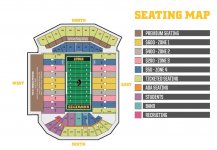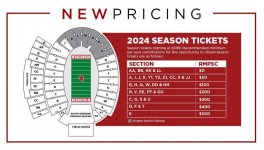Word
Eats difficult conversations
- Joined
- Jun 7, 2009
- Messages
- 13,005
- Reaction score
- 9,913
- Points
- 113
Do you have season tickets?With the population of the Twin Cities our stadium should be 75,000 capacity. Why the low interest?
Do you have season tickets?With the population of the Twin Cities our stadium should be 75,000 capacity. Why the low interest?
Do you think maybe the difference in game day revenue is largely due to Michigan selling 110, 000 tickets and Minnesota less tgan 50,000?the point is that it's not an even playing field. some schools recover a larger share of revenue from game-day operations and auxiliary activity, while other schools like MN recover a smaller share of revenue. If Neb gets a cut of parking, that gives them more resources than MN.
Football fans use the parking lot on game days. football fans purchase concessions on game days. football fans purchase merchandise on game days. that revenue would not exist if no game was being played. so I think it's fair that at least some of that revenue should go to the athletic department. Or - how about this - a share of those revenue sources go to the NIL collective?
the light rail is not running only for the football game. non football fans use the light rail on game days. so it is not specific to the game.
A very quick search on the google machine tells me, yes, our two biggest rivals are doing the exact same thing (I'd be pretty surprised if almost all B1G teams weren't doing this). Prices below are donations on top of actual ticket price, and note, they do not include premium seats.The season ticket donations are another thing. That system is not great and really led to a decrease in season tickets we haven't ever recovered from. Maybe the math works out that the decrease in season tickets purchased was more than made up for in the increase in season ticket revenue, but my gut says no and that the only reason it's still around is not wanting to admit it was a bad idea. Do any other B1G schools have a similar system in place?


Wikipedia’s 2022 attendance averaging 45,019 per game. If our revenue was $1.8 million per game, then that is only $39.98 per person. That seems very low for tickets and concessions.Does anyone have recent data, 2022 or 2023, for actual attendance at Gopher football games? Hard for all the no-shows counted in the announced attendance to contribute to non-ticket game-day revenue.
Agree. Very lowWikipedia’s 2022 attendance averaging 45,019 per game. If our revenue was $1.8 million per game, then that is only $39.98 per person. That seems very low for tickets and concessions.
45,019 was highly likely the sold number, not scanned tickets that were actually used. Even in the great 2019 season, scanned tickets were only 81.6% of the tickets the Gophers sold. In recent years, that percentage is likely materially lower, but haven’t seen the Strib or others report the recent actual figures.Wikipedia’s 2022 attendance averaging 45,019 per game. If our revenue was $1.8 million per game, then that is only $39.98 per person. That seems very low for tickets and concessions.

Sadly it does not, to the bean counters.However this does bring up the attendance and ticket price debate yet again. I personally think we could lower ticket prices and get more attendance, but the question is does the math work out in our favor?
Some number of thousands are student season tickets which are like $100 for the season? 5k?Wikipedia’s 2022 attendance averaging 45,019 per game. If our revenue was $1.8 million per game, then that is only $39.98 per person. That seems very low for tickets and concessions.
Yeah that alone .... nothing about that guy's post sense ... or at least the way it is presented / not how you would address any of it.Wikipedia’s 2022 attendance averaging 45,019 per game. If our revenue was $1.8 million per game, then that is only $39.98 per person. That seems very low for tickets and concessions.
They of course have the data for number of tickets scanned for each game. They'll never release that. It doesn't look nearly as good.45,019 was highly likely the sold number, not scanned tickets that were actually used. Even in the great 2019 season, scanned tickets were only 81.6% of the tickets the Gophers sold. In recent years, that percentage is likely materially lower, but haven’t seen the Strib or others report the recent actual figures.

New ticket data another measure of excitement over Gophers' football season
Successful season spurs not only more sales, but a higher percentage of those tickets actually being used.m.startribune.com
While the Gophers do get revenue from concessions, I would be surprised if it was more than 10-15% of the gross sales. So many others get a cut, plus there are lots of expenses.Do you think maybe the difference in game day revenue is largely due to Michigan selling 110, 000 tickets and Minnesota less tgan 50,000?
BTW, the Gophers do get revenue from concessions and merchandise.
Wouldn't all it take is the Strib or some other media outlet to do another story and request the information? I presume that's the only reason why the data was released in the article tagged in Post 38.They of course have the data for number of tickets scanned for each game. They'll never release that. It doesn't look nearly as good.
Good thought. That would certainly lower the income, but the revenue still seems low.Some number of thousands are student season tickets which are like $100 for the season? 5k?
It would be interesting to see a stadium revenue breakdown by ticket type, location, concessions, and scholarship donation. Like what do the suites and loge boxes bring in compared to other seating?Wouldn't all it take is the Strib or some other media outlet to do another story and request the information? I presume that's the only reason why the data was released in the article tagged in Post 38.
I’m sure they would give it to genuine media if asked (not some internet blog), or by FOIA request.Wouldn't all it take is the Strib or some other media outlet to do another story and request the information? I presume that's the only reason why the data was released in the article tagged in Post 38.
